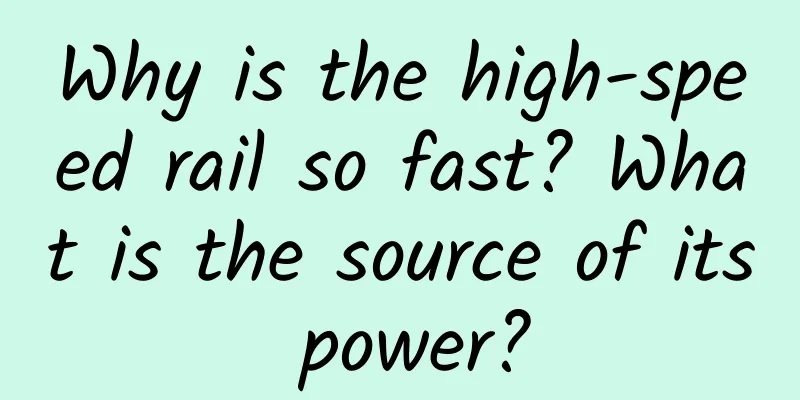Why is the high-speed rail so fast? What is the source of its power?

|
As a convenient means of transportation in today's human life, high-speed rail has completely changed our travel and life. The comfortable and fast high-speed rail has always been the first choice for people to travel far. However, although it also runs on rails, high-speed rail has abandoned this traditional energy supply method and chosen a new energy supply method - electricity. On the high-speed rail, there is hot water, lights, and charging, all of which are inseparable from "electricity". So, where does the electricity for high-speed trains come from? Where does it go in the end? How to ensure the safety of electricity use? First of all, the high-speed rail itself does not carry electrical energy and can only be provided by the electric traction power supply system, which mainly includes substations and contact networks. The substations are further divided into substation departments and distribution departments, and the two work together to complete the power supply work. Transformation is the process of transferring electric energy through a transformer. The voltage transmitted from the power plant is 220kV, so the EMU cannot use it directly. It must be converted to 27.5kV by the transformer in the substation. Distribution refers to the link in the power system that directly connects to the user and distributes electric energy to the user. High-speed trains obtain electricity through the overhead contact network above the track. The overhead contact network transmits the current to the EMU traction system through the pantograph on the roof of the EMU. When high-speed trains are running at high speed, the pantograph and the contact network are in "Z" shape contact to realize current supply. This can ensure that the pantograph and the contact network will not continuously generate friction at a certain point and affect their service life. The carbon slide plate is also an important component of the pantograph of the EMU. The working voltage of the contact network is 27.5kV. After the current enters the EMU, it must be transferred through the high-voltage equipment box, traction transformer and other equipment on the EMU, and converted into five types of constant current for use by different equipment. Two of the power sources are closely related to passengers' daily travel. One is AC220V, which supplies electricity to the power socket on the EMU, which can be used for small-power electrical appliances such as laptops, mobile phones, and tablets. The second is single-phase AC400V, which supplies power to equipment such as ventilation devices, EMU air conditioners, and restaurant electric tea stoves. Another type is DC100V, which continuously outputs electrical energy to keep the lights in the carriages bright at all times, and will not flicker due to changes in light and environment. A variety of lighting control modes are also set on the Fuxing EMU, and the brightness and warmth of the lights in the carriages and corridors will be automatically adjusted according to outdoor conditions. Features and benefits At the same time, the high-speed rail power supply system has the following features: 1. High power transmission efficiency. The high-speed rail runs at a very high speed. Traditional transmission lines will cause power loss due to long line distances, high resistance, and large energy losses. By setting up the substation at the center of the high-speed rail, the length and resistance of the transmission line can be reduced, thereby reducing power loss and improving power transmission efficiency. 2. High safety. High-speed railways run very fast. If traditional power supply methods are used, it is easy to cause safety problems such as electrical failures, line failures, and personal injuries. The use of high-speed rail power supply systems can reduce the number of power supply components, simplify the system structure, and reduce the probability of failures. At the same time, the high-speed rail power supply system is equipped with a high overhead line height, which can avoid vehicle collisions and ensure vehicle driving safety. 3. Environmental protection and energy saving. The high-speed rail power supply system uses electric energy. Compared with traditional fuel energy, power generation has less environmental pollution and is more in line with environmental protection and energy saving requirements. The above is some popular science about high-speed rail power systems. I hope it can be helpful to you! |
>>: Can gray hair turn black again? The doctor's answer is unexpected
Recommend
Use CocoaPods to print and receive messages for WeChat integrated SDK
Recommendation This article introduces a set of r...
Tencent Guangdiantong advertising placement and optimization!
In the 2020s, is there still anyone who doesn’t k...
iOS 16.4 Quick Security Response Update
Today, Apple released a quick security response u...
Alpha Egg Smart Dictionary Pen S Review: Connect to Huawei's smart ecosystem to create the best learning experience
In our primary and secondary school years, dictio...
Give technical staff some non-technical advice
[[233659]] I have been working in IT for many yea...
Is it expensive to produce the Yongzhou Glasses Mini Program? Yongzhou glasses applet production cost
The factors affecting the quotation of Yongzhou G...
"Six-dimensional Live Broadcast Startup" Complete video course + speech package (clothing, beauty, food, jewelry) + equipment list + Qianchuan courseware
"Six-dimensional Live Broadcast Startup"...
How to play with Tik Tok’s recommendation rules?
How to create a hit on Douyin? What are the six m...
The Woodpecker, the “Forest Doctor”? Is the Woodpecker a “Good Doctor”?
When talking about woodpeckers, the first thing t...
How to use the popular TV series "The Ming Dynasty" to attract targeted fans?
There is never a shortage of hot topics on the In...
Toutiao | Advertising Optimization Guide (Practical)
As one of the mainstream forms of mobile Internet...
Latest data! 34 new confirmed cases in 31 provinces, autonomous regions and municipalities, no new confirmed cases in Hubei
From 0:00 to 24:00 on March 18, 31 provinces (aut...
5 ways to build accounts for online alliance promotion
1. Account Structure Concept The account structur...
DOPDropDownMenu-Enhanced
Source code introduction: On this basis, I beauti...









